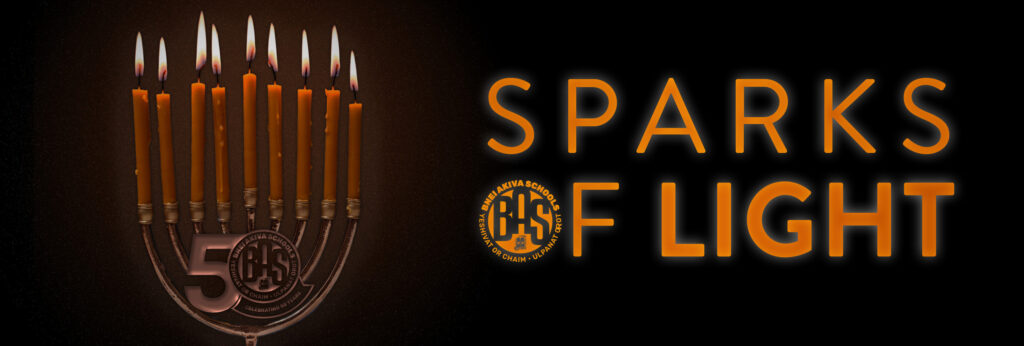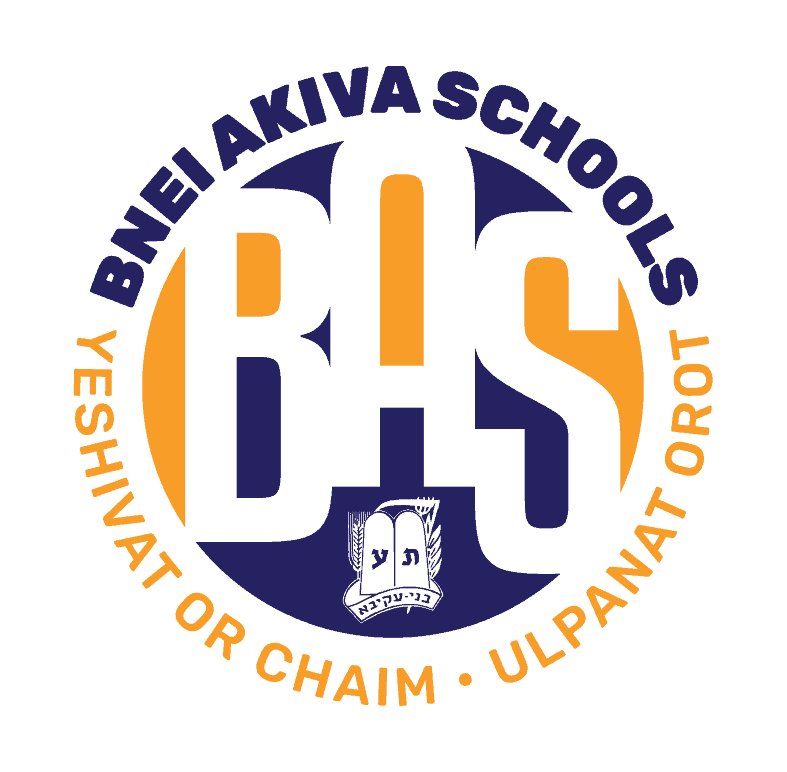
Zot Chanukah – This Is Chanukah
Mrs. Rina Deutsch
Judaic Studies
As we all know, there is a debate between Beit Shammai and Beit Hillel over how we are meant to light our Chanukiot. Beit Shammai says we begin with all eight lights aglow and we take one away each night until the last night when we light one. Beit Hillel says that we start with one light and work our way up to a full Chanukiah on the eighth night.
In Masechet Shabbat (21b), the reason we’re given for lighting according to Hillel’s opinion is “D’malin b’kadosh, v’ein moridin”–we only increase in holiness, we don’t decrease. But there’s an even deeper idea behind the discrepancy between their opinions.
Beit Shammai sees the world through the lens of potential, taking into account HaShem’s perspective. Thus, on the first night of Chanukah, all the potential of the nes was already there. HaShem knew that the oil would last eight nights. Kindling all the Chanukah lights on the first night speaks to the power of the nes which was unlocked the moment the Maccabees lit the Menorah in the Beit HaMikdash. For this reason, Beit Shammai says we begin with eight lights, to celebrate the full potential of the nes that was there from the beginning.
Beit Hillel sees the world through the lens of actuality, taking into account humanity’s perspective. There was no way for the Maccabim to know that the scant amount of oil they found would burn beyond then and there. Looking at the reality in front of them, they did what they needed to do and lit the oil that was available to them in the moment. For this reason, Beit Hillel says we begin with one light and then add a light according to the day in accordance with the actual reality in front of us.
It would seem that these two ideas, seeing the potential and looking at the actuality, are at odds with one another. Either we envision what could be or we deal with what is. There doesn’t seem to be a way to do both.
While it’s “one or the other” scenario when it comes to lighting the Chanukiah, most of life isn’t actually that black and white. I would humbly suggest that, as Jews, finding a way to live with this contradiction is something we must strive to do; to deal both with the reality in front of us and at the same time see the potential and strive for more and for better.
The ability to do this is no small feat. Especially with what is happening right now–the war in Israel, the brazen antisemitism around the world–it is all too easy to look at the actuality and lose hope for the potential of goodness, of hope, of redemption. But when we look back at the Chanukah miracle, though it didn’t lead us to the final redemption, it reminds us of the potential, the love that HaShem offers us even in the midst of the most difficult reality, and the promise of better things to come.

Menachem Schachter
Student, Grade 11 Yeshivat Or Chaim
The Rambam states in Hilchos Chanukah: If a poor person has to choose whether to spend money on Chanukah candles or for Shabbos candles, he should spend it on Shabbos candles first. The Rambam explicitly states the source for this halacha, stating that it is found in masechet Shabbos. The gemara talks about a Sotah, mentioning that Hashem’s name should be erased to keep peace within the house. The Rambam learns from here that every mitzvah has a role in creating peace in the world, meaning Shabbos candles also bring peace.
There is an issue with the statement. How can the Rambam compare the case of a Sotah to the Shabbos candles? In the case of the Sotah, a family is literally on the verge of falling apart. That family needs someone to violate the prohibition of erasing Hashem’s name in order to save them. However, with Shabbos candles, all the candles do is add an extra piece of harmony to the home. So why is the halacha like this? Another inconsistency with the Rambam is that he is trying to stress the importance of Shabbos candles compared to Chanukah candles. So why would he write the halacha for it in Hilchos Chanukah, when wouldn’t it make much more sense to include it in Hilchos Shabbos? To strengthen this question, both the Tur and the Shulchan Aruch write about the halacha in Hilchos Shabbos. Why doesn’t the Rambam do the same?
The Rambam writes that the purpose of lighting Shabbos candles is not for harmony like stated earlier; rather, it is to bring honour and pleasure to Shabbos. By mentioning Shabbos candles together with Chanukah candles, the Rambam adds an additional dimension to this mitzvah. Says the Rambam, every mitzvah has a role in creating peace in the world. The Lubavitcher Rebbe says that the meaning of peace is when two opposing forces come together as one to unify with Hashem. Chanukah commemorates the winning of the war to bring peace in order to serve Hashem properly. Shabbos candles show even more of the constant unconditional connection between us and Hashem to bring peace – to an even greater degree than Chanukah candles. Therefore, they have precedence. This is why if a poor person has to choose whether to spend money on Chanukah candles or Shabbos candles, he should spend it on Shabbos candles first. May the merit of doing the mitzvah of lighting Chanukah candles and of Shabbos candles bring peace in Eretz Yisroel. Chag Sameach!

Shira Kronenberg
Student, Grade 12 Ulpanat Orot
וְעַל הַנִּסִּים is a prayer that we add to שמונה עשרה and ברכת המזון during the eight days of Chanukah. It’s a widely known prayer, one we immediately associate with Chanukah and are often able to sing by heart. It describes the many miracles that took place in the time of the Maccabees. For instance, it celebrates the miracle of the Jews winning the impossible war against the Greeks (מָסַרְתָּ גִּבּוֹרִים בְּיַד חַלָּשִׁים וְרַבִּים בְּיַד מְעַטִּים – You delivered the mighty into the hands of the weak, the many into the hands of the few). It also records the miracle of the Jews being able to re-sanctify the Beit Hamikdash and light the menorah (וְאַחַר כֵּן בָּאוּ בָנֶיךָ לִדְבִיר בֵּיתֶךָ וּפִנּוּ אֶת הֵיכָלֶךָ וְטִהֲרוּ אֶת מִקְדָּשֶׁךָ וְהִדְלִיק נֵרוֹת בְּחַצְרוֹת קָדְשֶׁךָ – then Your children entered the shrine of Your House, cleansed Your Temple, purified Your Sanctuary, kindled lights in Your holy courtyards). Yet there is an essential miracle of Chanukah that is completely omitted.
Why do we celebrate Chanukah? Why do we light candles for eight days? The standard answer, the one we all know instantly, is that we celebrate Chanukah because the oil that was meant to last only one night miraculously lasted eight. The Jews had found one sealed jug of pure olive oil meant to last just one night, but Hashem made the oil last eight nights to allow them enough time to press new oil. Why is this miracle, the one we universally associate with Chanukah, completely omitted in וְעַל הַנִּסִּים?
Rav Yisroel Landau, the Rabbi of Edelenyi in the 1920s, explains that the prayer of וְעַל הַנִּסִּים was created with the express purpose of thanking Hashem for the miracles that He brought about to our ancestors – שֶׁעָשִׂיתָה לַאֲבוֹתֵינוּ – to the Jewish community that lived in those days. These were accomplishments, miraculous accomplishments, that came about as a result of the Jewish people coming together to accomplish a shared goal. Beating the Greeks, clearing and cleansing the Beit Hamikdash, and lighting the menorah were all communal accomplishments. As great as the miracle of the oil lasting eight days was, it was a different type of miracle. It was Hashem’s way of elevating the holiness of the Beit Hamikdash, but it was not directly caused by the Jewish community. Therefore, despite its importance, it does not belong in וְעַל הַנִּסִּים.
In these difficult times, it is important to remember that the הַגְּבוּרוֹת וְהַתְּשׁוּעוֹת (the mighty deeds and the salvations), the miracles we celebrate, came about as a direct result of our forefathers joining together sharing a common set of goals. It is when we as a community band together that Hashem brings about the miracles we need to defeat our enemies and brings cause for celebration. Chag sameach!


